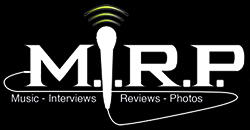What a beautiful venue Seattle’s Paramount Theater is. Normal-ish looking from the outside, but absolutely stunning inside. […The opulent theater is known for its lavish decoration reminiscent of the Palace of Versailles.”] – per Wikipedia. It was exquisite…fitting for the exquisite band that is Meshuggah.
I arrived from Portland early and stood in line to talk to some of the people who had gathered. One was from Utah, another from Idaho, and one from Eastern Washington; they were all there for Meshuggah. The appeal of Meshuggah is strong to those who “get it.” After my visit with the out-of-towners, I headed over to a nearby coffee shop where I met a nice, pretty lady who was a big fan of Meshuggah. We chatted over our favorite songs and excitement for the show, and then parted ways. I ordered a latte, sat down, and to my surprise, took a video call from a former member of In Flames before meeting up with a Seattle Photographer for dinner.
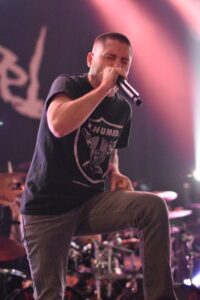 Once inside, I found myself amongst some of the best photographers in the Pacific Northwest and, must admit, was a little intimidated. You see, I’m a writer not a photographer, but sometimes find myself in the position of both. Interviewing musicians is easy; photographing them is not as easy for me. My gear paled in comparison to the dual camera, long lenses that surrounded me. The Seattle photographers (also friends of mine) welcomed me with open arms, and I felt at ease as Tennessee’s Whitechapel took the stage.
Once inside, I found myself amongst some of the best photographers in the Pacific Northwest and, must admit, was a little intimidated. You see, I’m a writer not a photographer, but sometimes find myself in the position of both. Interviewing musicians is easy; photographing them is not as easy for me. My gear paled in comparison to the dual camera, long lenses that surrounded me. The Seattle photographers (also friends of mine) welcomed me with open arms, and I felt at ease as Tennessee’s Whitechapel took the stage.
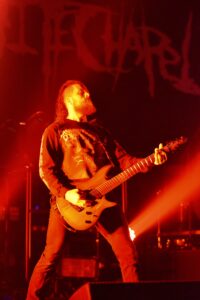
Being an extreme music journalist, sometimes it is hard to find the proper words to adequately describe the bands without being redundant or obnoxious. Words like brutal, pummeling breakdowns, onslaught, surgical precision, guttural growls, relentless, down-tuned guitars, extreme, melodic, tuneful, rich, mellifluous, discordant, hardcore, rhythmic, complex, shredding riffs, growling, roaring, heavy, aggressive, etc., but all of those adjectives DO describe the bands. I’ll hold off on “discordant” and “complex” thought, until we get to Meshuggah.
Polished, professional, fun, heavy; whomever put this tour together was smart by putting deathcore royalty Whitechapel, with Swedish melodic metalists In Flames, and the very complicated and complex band Meshuggah. To bring Whitechapel to the older In Flames fans, to bring In Flames to the younger Whitechapel fans, and to blend both with Meshuggah fans was brilliant.
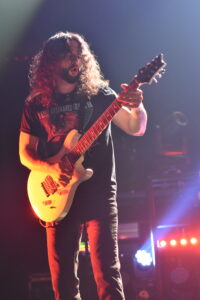 The loudest chatter I heard about Whitechapel was the set was too short at 20 minutes and there wasn’t a lot of traditional interaction with the fans by the vocalist. Not to fear, die hard Whitechapel fans came to the band’s rescue online to complainers, reminding them that Whitechapel could headline a show themselves, on their own accord, but their job was to set the tone for two Swedish Giants, and it made sense for them to talk less to play more.
The loudest chatter I heard about Whitechapel was the set was too short at 20 minutes and there wasn’t a lot of traditional interaction with the fans by the vocalist. Not to fear, die hard Whitechapel fans came to the band’s rescue online to complainers, reminding them that Whitechapel could headline a show themselves, on their own accord, but their job was to set the tone for two Swedish Giants, and it made sense for them to talk less to play more.
The fan attendance didn’t seem to ebb and flow for one band over another, as so many of the fans came to witness all of the bands. Of note, the line for merch for all three bands wound all of the way up the stairs of the majestic theater the entire night.
With little to no conversation, Vocalist Phil Bozeman commanded the audience with his brilliant guttural vocals starting the set off with “Let Me Burn.” As stated, the set was short, but the men of Whitechapel were able to cram into the short set, “Forgiveness Is Weakness,” “Brimstone,” “I Will find You,” A Bloodsoaked Symphony,” and “The Saw Is The Law,” before they had to make way for In Flames. With all three bands’ equipment set up in tandem, the Paramount Theater’s voluptuous stage allowed Whitechapel to shine and move around well, and the sound was spot on.
Timed perfectly, In Flames took the stage. Shooting the first three songs, I turned to the crowd and saw all every one of the people I met in line in front, as well as my new friend from the coffee shop. Crammed up against the barrier, everyone was smiling and looked excited for In Flames.
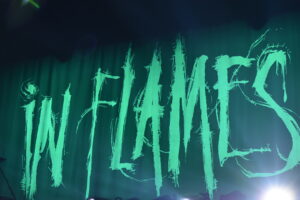 In Flames is a band that has changed a bit over the years. From the departure of founding member Jesper Stromblad in 2010, to the exit of Daniel Svensson and Peter Iwers in 2015/16, In Flames has veered a bit from its’ classic style. Like it or not, In Flames was savvy and played a set that included songs both old and new, pleasing everyone.
In Flames is a band that has changed a bit over the years. From the departure of founding member Jesper Stromblad in 2010, to the exit of Daniel Svensson and Peter Iwers in 2015/16, In Flames has veered a bit from its’ classic style. Like it or not, In Flames was savvy and played a set that included songs both old and new, pleasing everyone.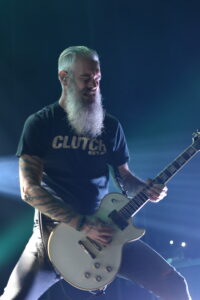
Vocalist Anders Frieden was full of love for the fans and longtime guitarist Bjorn Gelotte, opining, “Sometimes I feel like I’m married to this guy [referring to Gelotte.]” Between songs he often spoke about taking care of each other, and admiration of his current bandmates.
With bright lighting, I was thrilled to photograph Gelotte this time around. In Portland, a few years ago, I had the pleasure of interviewing Bjorn, and it was my first time ever shooting a show. He gave me incredible shots from the stage, but my shyness and lack of experience birthed only hazy, blurry, bumbling photos.
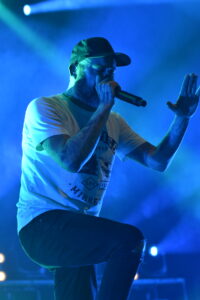 In Flames’ first song was “Foregone Pt. 1,” followed up by “Deliver Us,” “Darker Times,” “Everything’s Gone,” “All For Me,” “Behind Space,” and then the beloved “Cloud Connected,” to which the crowd erupted, singing every word. “State of Slow Decay,” was next, followed by the mighty “Mirror’s Truth.” While it appeared the fans didn’t know the newer songs as well as the classics, “I Am Above,” was a strong crowd song, but not as strong as the final song, “Take This Life,” which was an all-out “onslaught” of crowd participation. Melodic and quite pretty, In Flames performed a beautiful set. Tanner Wayne backed the band well laying down the beat with “surgical precision,” while rhythm guitarist Chris Broderick supported Gelotte flawlessly. Frieden poked a little fun at Broderick’s physic referring to his muscular build and perfectly toned body.
In Flames’ first song was “Foregone Pt. 1,” followed up by “Deliver Us,” “Darker Times,” “Everything’s Gone,” “All For Me,” “Behind Space,” and then the beloved “Cloud Connected,” to which the crowd erupted, singing every word. “State of Slow Decay,” was next, followed by the mighty “Mirror’s Truth.” While it appeared the fans didn’t know the newer songs as well as the classics, “I Am Above,” was a strong crowd song, but not as strong as the final song, “Take This Life,” which was an all-out “onslaught” of crowd participation. Melodic and quite pretty, In Flames performed a beautiful set. Tanner Wayne backed the band well laying down the beat with “surgical precision,” while rhythm guitarist Chris Broderick supported Gelotte flawlessly. Frieden poked a little fun at Broderick’s physic referring to his muscular build and perfectly toned body.
Being a huge In Flames fan for many years, I was pleased with how they performed both old and new songs, but especially the old.
Now for Meshuggah. The last time I saw Meshuggah was at Portland’s Crystal Ballroom (the one with the bouncing floor). I was covering the band while MIRP’s real photographer was shooting. I had a special bracelet for media, but it really didn’t give me any special features.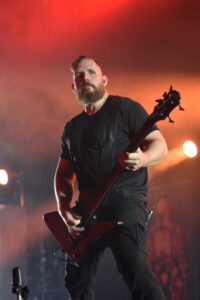
That is until my photographer called me and told me to get downstairs. I fought back, as I had the perfect spot in the balcony. I finally conceded and went downstairs knowing I would lose my pristine spot, only to be walked by security past the over 21 section and bar, to a little corner of the barricade, smack dab in front of Dick Lovgren. No moshers, just me and Dick. It was spellbinding.
On this night, however, I positioned myself right in front of where I knew Dick would be and the red lights came on. Convulsion-provoking flashes of light with simple shadows of each member behind a backlit box was what we saw as we began to hear the complex “Broken Cog.” Eventually the backlight revealed the musicians in full form, and they were in vivid lighting by the time they started “Rational Gaze.” Meshuggah is a band that is like a virus. Hold on, give me a chance here…. they defy the traditional definition of extreme music and the first time you listen to a song it can be really “discordant” and uncomfortable. That is one of the things I love about Meshuggah. For those of us who “get it,” once it gets inside of you, like in your blood and cells, and you understand every twist and turn of their “complex” arrangement, and find that every note that felt wrong at first now feels right, there is absolutely nothing more satisfying. 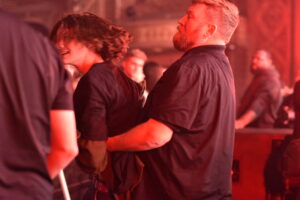
During the three-song shoot, I shot next to Jens Kidman’s fiancé, who was solovely, as well as the Seattle photographers that I am such a fan of. We did leapfrog dancing, courteous of each other, remembering to not linger too long in one spot, and to not obstruct each other’s view. 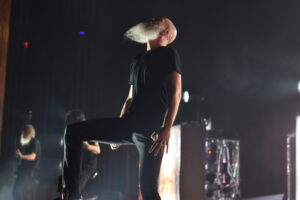
“Perpetual Black Second,” was followed by “Electric Red.” Two of my personal favorites (and the crowd’s favorites by their response) were the next songs: “Born in Dissonance,” and “Ligature Marks,” where fans continued to really crowd surf to the front of the theater, to be gently plucked from the hands that held them up by security.
I love watching Dick Lovgren play the boxy “complex” rhythms of these songs. He stands with his feet firmly placed, eyes closed, and slowly and slightly moves his body with the precise varied rhythm of each song. “The Abysmal Eye,” “In Death – Is Life,” “Humiliative,” rounded out the set, to be followed by the obviously needed (because we can never have too much Meshuggah) “Bleed,” and “Demiurge.”
It was a perfect night.
After Meshuggah exited the stage, I ran out to the lobby to see if the line was still as long as it had been all night. Good luck was on my side as I was able to grab Meshuggah shorts and other merch, and then headed back to Portland in the dense fog, going 40 in a 70 with my flashers on, reminiscing about what I had just witnessed.

